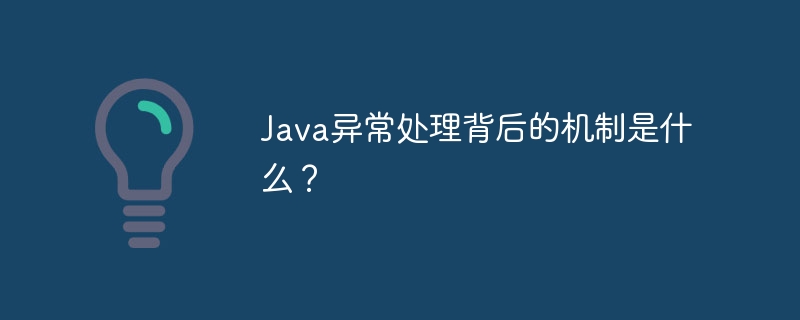Home >Java >javaTutorial >What is the mechanism behind Java exception handling?
What is the mechanism behind Java exception handling?
- 王林Original
- 2024-04-12 09:33:02835browse
Java exception handling mechanism uses exceptions, exception handlers and try-catch blocks. The handler catches and handles exceptions according to the exception type. In a try-catch block, exceptions in the try block are caught and executed by the matching catch block, allowing the program to handle errors gracefully and remain stable under unexpected circumstances.

The mechanism behind Java exception handling
Exception handling in Java provides a mechanism to handle errors and unexpected situations during program execution. It allows you to handle errors gracefully and keeps your application stable when problems arise.
Exception mechanism
Java exception handling mechanism is based on the following key components:
- Exception:A Java class that represents an exception that occurs in an application Errors or unexpected conditions.
- Exception handler: Code block used to handle specific exception types.
- throw: A keyword used to throw an exception.
- try-catch: A syntax block used to handle exceptions that may be thrown in the try block.
How try-catch block works
The try-catch block is used to catch and handle exceptions in a piece of code. It has the following syntax:
try {
// 代码块可能抛出异常
} catch (ExceptionType1 e1) {
// 处理 ExceptionType1 异常
} catch (ExceptionType2 e2) {
// 处理 ExceptionType2 异常
}When the code in the try block encounters an exception, the Java Virtual Machine (JVM) looks for the first catch block that matches the exception type. If a matching block is found, the code in that block is executed and the remaining code in the try block is skipped.
Practical Case
The following is a code snippet showing how the try-catch block works:
import java.io.File;
import java.io.FileNotFoundException;
public class ExceptionHandlingExample {
public static void main(String[] args) {
try {
// 打开一个不存在的文件
File file = new File("non-existent-file.txt");
// 尝试读取文件的内容
String content = new Scanner(file).nextLine();
} catch (FileNotFoundException e) {
// 处理文件不存在异常
System.out.println("文件不存在!");
}
}
}In this example, the try block attempts to open a file that does not exist, This may throw a FileNotFoundException. If an exception is thrown, the catch block will catch it and handle it, printing a message stating that the file does not exist. If no exception occurs, the catch block will be skipped and the remaining code in the try block will be executed.
The above is the detailed content of What is the mechanism behind Java exception handling?. For more information, please follow other related articles on the PHP Chinese website!

